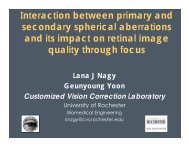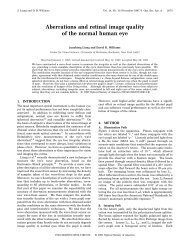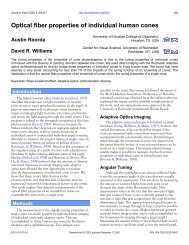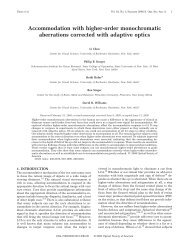Compensation of corneal aberrations by the ... - Journal of Vision
Compensation of corneal aberrations by the ... - Journal of Vision
Compensation of corneal aberrations by the ... - Journal of Vision
You also want an ePaper? Increase the reach of your titles
YUMPU automatically turns print PDFs into web optimized ePapers that Google loves.
Artal, Guirao, Berrio & Williams 4ResultsThe results presented in this section are direct measurements<strong>of</strong> <strong>the</strong> <strong>aberrations</strong> <strong>of</strong> <strong>the</strong> anterior <strong>corneal</strong> surface and <strong>the</strong> completeeye, and indirect estimates <strong>of</strong> <strong>the</strong> <strong>aberrations</strong> <strong>of</strong> <strong>the</strong> internalsurfaces. Figure 6 shows a representative example <strong>of</strong> <strong>the</strong> results for1 <strong>of</strong> <strong>the</strong> subjects: <strong>the</strong> WA maps for <strong>the</strong> cornea (A), <strong>the</strong> internaloptics (B), and <strong>the</strong> complete eye (C) toge<strong>the</strong>r with <strong>the</strong>ir associatedPSFs calculated at <strong>the</strong> best image plane (D-F). In this subject, <strong>the</strong>magnitude <strong>of</strong> <strong>aberrations</strong> is larger in <strong>the</strong> cornea than in <strong>the</strong>complete eye. This can be easily noted in <strong>the</strong> wrappedrepresentation <strong>of</strong> <strong>the</strong> WAs <strong>by</strong> counting <strong>the</strong> number <strong>of</strong>phase-steps appearing in <strong>the</strong> maps for <strong>the</strong> cornea and for<strong>the</strong> complete eye, or, alternatively, <strong>by</strong> comparing <strong>the</strong>spreads <strong>of</strong> <strong>the</strong> associated PSFs.Figure 7 shows <strong>the</strong> Zernike terms for <strong>the</strong> <strong>aberrations</strong> <strong>of</strong><strong>the</strong> cornea (solid symbols) and <strong>the</strong> internal optics for allsubjects. The magnitude <strong>of</strong> <strong>the</strong> most important aberrationterms is similar for <strong>the</strong> two components, but with a changein sign. This produces an eye with smaller amounts <strong>of</strong><strong>aberrations</strong> than its main components, indicating that <strong>the</strong>internal optics partially compensate for <strong>the</strong> <strong>aberrations</strong> <strong>of</strong><strong>the</strong> anterior surface <strong>of</strong> <strong>the</strong> cornea. Figure 8 shows <strong>the</strong> rootmean square <strong>of</strong> <strong>the</strong> WA (a parameter indicating <strong>the</strong>magnitude <strong>of</strong> <strong>the</strong> aberration) for <strong>the</strong> eye, <strong>the</strong> anteriorsurface <strong>of</strong> <strong>the</strong> cornea, and <strong>the</strong> internal optics for 6 eyesafter defocus was removed. In every case, <strong>the</strong> <strong>aberrations</strong> <strong>of</strong><strong>the</strong> <strong>corneal</strong> surface and <strong>the</strong> isolated internal optics arelarger than those <strong>of</strong> <strong>the</strong> total eye.a b cd e fFigure 6. A-C. Wave-front aberration (WA) maps for <strong>the</strong> cornea(A), <strong>the</strong> internal optics (B) and <strong>the</strong> complete eye (C). These WAsare represented as modulo-π. The pupil diameter was 5.9 mm.D-E. Associated point-spread functions (PSFs) calculated at <strong>the</strong>best image plane from WA panels A-C. Each image subtends 20minutes <strong>of</strong> arc <strong>of</strong> visual field.microns0.80.40.0-0.4-0.8C -2 2 C 2 2C -1 3 C 1 3 C -3 3 C 3 3 C 0 4 C 2 4 C -2 4Zernike termsFigure 7. Zernike terms for <strong>the</strong> cornea (solid symbols) and <strong>the</strong>internal optics (open symbols) for all subjects.RMS (microns)1.41.21.00.80.60.40.20.0corneainternaleyesubjectC 4 4Figure 8. Root mean square <strong>of</strong> <strong>the</strong> wave-front aberration <strong>of</strong> <strong>the</strong>eye (squares), <strong>the</strong> cornea (circles), and <strong>the</strong> internal optics(triangles) for 6 eyes after defocus was removed.Figure 9 shows <strong>the</strong> values <strong>of</strong> <strong>the</strong> Zernike terms up t<strong>of</strong>ourth order (from 5 to 14) for all subjects for <strong>the</strong> <strong>corneal</strong>surface versus <strong>the</strong> internal optics. There is a significantnegative correlation between <strong>corneal</strong> and internal optics<strong>aberrations</strong> (regression coefficient, 0.86). This resultindicates a significant coupling <strong>of</strong> individual aberrationterms between <strong>the</strong> cornea and <strong>the</strong> internal ocular optics.Astigmatism for <strong>the</strong> cornea and internal optics (Zerniketerms 5 and 6) had opposite signs. Figure 10 shows <strong>the</strong>astigmatism <strong>of</strong> <strong>the</strong> <strong>corneal</strong> surface versus <strong>the</strong> internaloptics. This supports a well-known fact in clinical practice:<strong>the</strong> internal optics tend to compensate for <strong>the</strong> <strong>corneal</strong>astigmatism. However, what is more surprising is that thiscompensation also takes place for higher order <strong>aberrations</strong>.Third- and fourth-order <strong>aberrations</strong> were also partiallycompensated. A large fraction <strong>of</strong> <strong>the</strong> spherical aberration <strong>of</strong><strong>the</strong> cornea is cancelled <strong>by</strong> <strong>the</strong> internal optics. Themagnitude <strong>of</strong> comalike <strong>aberrations</strong> <strong>of</strong> <strong>the</strong> cornea is alsosignificantly reduced <strong>by</strong> <strong>the</strong> internal optics. Figure 11 shows







